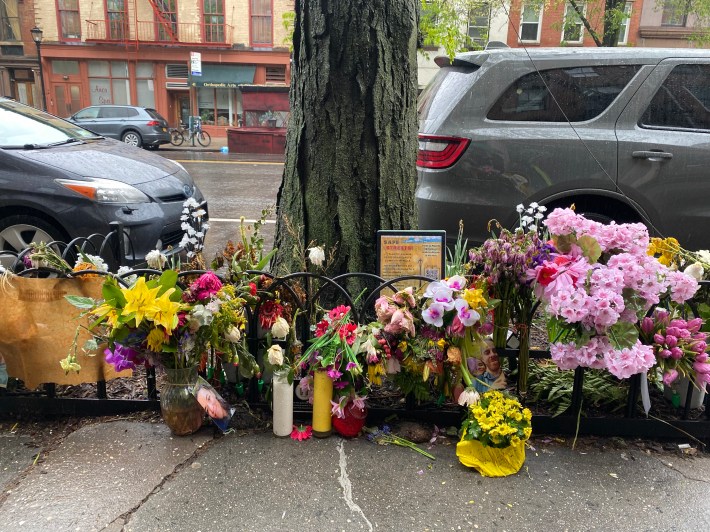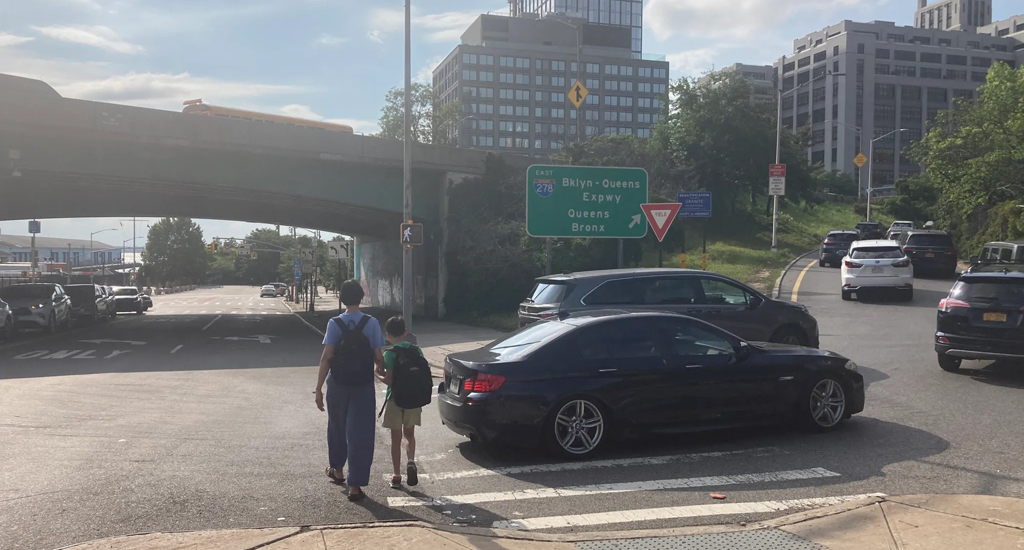The city should improve safety on deadly Atlantic Avenue by adding more mid-block crosswalks and banning some parking to improve visibility for drivers, members of Brooklyn Community Board 2 said last week, though the panel stopped short of calling for larger-scale changes, such as narrowing the road.
CB 2's Transportation and Public Safety committee on Thursday called for those minor changes to Brooklyn's "Boulevard of Death," where drivers have killed six pedestrians since 2014.
The vote came after board staff presented the results of a block-by-block walk-through of the portion of Atlantic Avenue within the district’s boundaries, a nearly 1.5-mile stretch from the East River waterfront to the Barclays Center. Over the past decade on that strip, there have been 4,525 reported crashes — more than one a day — resulting in eight total fatalities, including the six people on foot, and 1,190 injuries.
“[People have a] general feelings of not feeling super safe as a pedestrian, traffic was a little crazy, traffic was stalling in the middle of crosswalks, and just the general feeling of cars not really regarding pedestrians,” said Walker Johnston, a community associate at CB2’s district office.

The committee's action comes nearly a year after a speeding driver broke a red light and slammed into 31-year-old Katie Harris at Clinton Street, throwing her halfway down the block.
Harris’s brutal death revived a longstanding push by local advocates and pols for a safer thoroughfare, prompting DOT to install three mid-block crossings (between Bond and Nevins, between Hoyt and Bond and between Smith and Hoyt) — none of them at the junction where the Brooklynite died.
The panel's resolution called for two more mid-block crossings between Court and Henry streets, and for the city to fortify all of the existing mid-block crosswalks with concrete sidewalk extensions. Illegally parked cars often block the new crosswalks added by DOT in recent months.
The panel also voted to clear corners of parking — an increasingly popular street safety tool known as daylighting — at five crash-prone intersections: Hicks Street, Clinton Street, Court Street, Nevins Street, and Third Avenue.
The intersection of Atlantic at Nevins — which boasted a grim 151 reported crashes, one fatality and 61 injuries since 2014 — should get a protected left-turn bay with a separate signal and a protected pedestrian island, the panel said. Turning drivers routinely try to beat pedestrians crossing the street, residents at the meeting said.
Board members also called on the city to shorten the time that lights are green for cars near the chaotic entrance ramps to the Brooklyn-Queens Expressway at Hicks Street.
Speaking at Thursday's meeting, Council Member Lincoln Restler pledged to push the Adams administration to do more to undo the decades of death and destruction caused by the artery’s highway-like design.

Restler said the Department of Transportation agreed to study the two blocks where CB 2 asked for more mid-block crossings next month, and if agency officials see enough people crossing between intersections, they will add the extra pedestrian markings.
“Crossing Atlantic has been something that I've been afraid of since I was a little boy ... and it hasn't changed,” Restler said. “The current conditions at Atlantic are totally unsafe, and we're not gonna let them get away with not making improvements.
“We also asked DOT to undertake a broader study of Atlantic Avenue to think about what would be the impact of reducing a lane of traffic or other major changes, and how could that work and what would that look like — not saying that we need it, just saying that we want to understand what that study would be," the pol added.

The civic panel did not propose larger-scale changes, such as narrowing the road, which currently hosts six lanes for the movement and storage of motor vehicles and gets heavy truck traffic. Big rigs routinely destroy existing infrastructure, such as a walk signal at Third Avenue that motorists have rammed down repeatedly.
"It’s been knocked over seven times in the last year," said Kelly Carroll, executive director of the Atlantic Avenue BID.

City officials have studied Atlantic Avenue and the surrounding street grid since at least the Giuliani administration, but neglected to reduce the space for cars.
The city has been hesitant to make any substantial changes near the BQE because transportation officials worry those could interfere with DOT's study of whether to re-widen the highway's triple cantilever section from two lanes in each direction to three as part of its $5.5 billion reconstruction, Restler claimed.
Street safety activists called on Mayor Adams to seize the momentum and finally make all of Atlantic safe.
“For far too long, cars and trucks have gotten the overwhelming majority of space on Atlantic and it's time for Mayor Adams to correct this wrong along the entire corridor,” said Kathy Park Price, Brooklyn organizer for Transportation Alternatives.
“We demand a safe Atlantic Avenue — along the entire corridor — that prioritizes the needs of pedestrians, bike riders, and bus riders.”
For its part, the DOT says it is pleased to hear from active boards like CB2.
“DOT has completed a number of safety projects along Atlantic Avenue in recent years, including the construction of major street redesign work and new mid-block pedestrian crossings along the entire corridor," said agency spokesman Vin Barone. "We appreciate the board’s support and will be reviewing their requests.”
The eastern part of Atlantic Avenue was named a "Great Streets" project under the previous mayor. Work between Pennsylvania Avenue and Logan Street led to a 39-percent reduction in pedestrian injuries and 14-percent reduction in cyclist injuries, according to the agency. Work to the east of Logan Street, which will include a protected bike lane, is ongoing. That plan, however, was presented to Brooklyn Community Board 5 in 2018 and was supposed to begin in 2019.






